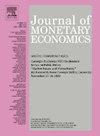The real effects of financial disruptions in a monetary economy
IF 4.3
2区 经济学
Q1 BUSINESS, FINANCE
引用次数: 0
Abstract
A large literature in macroeconomics concludes that disruptions in financial markets have large negative effects on output and (un)employment. Though diverse, most papers in this literature share a common characteristic: they employ frameworks where money is not explicitly modeled. This paper argues that the omission of money may hinder a model’s ability to evaluate the real effects of financial shocks, since it deprives agents of a payment instrument that they could have used to cope with the resulting liquidity disruption. In a carefully calibrated New-Monetarist model with frictional labor, product, and financial markets, we show that the existence of money dampens or even nearly eliminates the real impact of financial shocks, depending on the nature of the shock. We also show that the propagation of financial shocks to the real economy depends on the inflation level: high inflation levels magnify the real effects of adverse financial shocks.
货币经济中金融混乱的实际影响
宏观经济学中有大量文献认为,金融市场的混乱会对产出和(非)就业产生巨大的负面影响。尽管观点各异,但这些文献中的大多数论文都有一个共同特点:它们采用的框架没有明确地模拟货币。本文认为,忽略货币可能会妨碍模型评估金融冲击实际影响的能力,因为这使代理人失去了一种支付工具,而他们本可以用这种工具来应对由此产生的流动性中断。在一个经过仔细校准的具有摩擦性劳动力、产品和金融市场的新货币主义模型中,我们表明货币的存在会抑制甚至几乎消除金融冲击的实际影响,这取决于冲击的性质。我们还表明,金融冲击对实体经济的传播取决于通胀水平:高通胀水平会放大不利金融冲击的实际影响。
本文章由计算机程序翻译,如有差异,请以英文原文为准。
求助全文
约1分钟内获得全文
求助全文
来源期刊

Journal of Monetary Economics
Multiple-
CiteScore
7.20
自引率
4.90%
发文量
90
审稿时长
74 days
期刊介绍:
The profession has witnessed over the past twenty years a remarkable expansion of research activities bearing on problems in the broader field of monetary economics. The strong interest in monetary analysis has been increasingly matched in recent years by the growing attention to the working and structure of financial institutions. The role of various institutional arrangements, the consequences of specific changes in banking structure and the welfare aspects of structural policies have attracted an increasing interest in the profession. There has also been a growing attention to the operation of credit markets and to various aspects in the behavior of rates of return on assets. The Journal of Monetary Economics provides a specialized forum for the publication of this research.
 求助内容:
求助内容: 应助结果提醒方式:
应助结果提醒方式:


